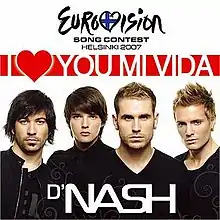I Love You Mi Vida
"I Love You Mi Vida" (Spanish pronunciation: [aj ˈlov ʝu mi ˈβiða], "I Love You My Darling") is a song recorded by Spanish boy band D'Nash. The song was written by Thomas G:son, Andreas Rickstrand, Tony Sánchez-Ohlsson and Rebeca. It is best known as the Spanish entry at the Eurovision Song Contest 2007, held in Helsinki.
| "I Love You Mi Vida" | ||||
|---|---|---|---|---|
 | ||||
| Single by D'Nash | ||||
| from the album Capaz De Todo (Misión Eurovisión Version) | ||||
| Released | March 19, 2007 (Spain - radio) | |||
| Genre | Pop, dance | |||
| Length | 3:03 | |||
| Songwriter(s) | Thomas G:son, Andreas Rickstrand, Tony Sánchez-Ohlsson, Rebeca Pous del Toro | |||
| D'Nash singles chronology | ||||
| ||||
| Eurovision Song Contest 2007 entry | ||||
| Country | ||||
| Artist(s) | ||||
| As | ||||
| Languages | ||||
| Composer(s) |
| |||
| Lyricist(s) | ||||
| Finals performance | ||||
| Final result | 20th | |||
| Final points | 43 | |||
| Entry chronology | ||||
| ◄ "Un Blodymary" (2006) | ||||
| "Baila el Chiki-chiki" (2008) ► | ||||
The song was entered into Misión Eurovisión 2007, which was the Spanish national preselection for the Eurovision Song Contest 2007. The song was Spain's representative at the Eurovision Song Contest 2007 in the Hartwall Areena in Helsinki, Finland. In the final, it was performed second, following Bosnia and Herzegovina's Marija Šestić with "Rijeka bez imena" and preceding Belarus' Dmitry Koldun with "Work Your Magic". It finished 20th with 43 points, a similar result from that of the Eurovision Song Contest 2006 with Las Ketchup's "Un Blodymary", which finished 21st with only 18 points.
The song was succeeded as Spanish entry at the 2008 Contest by Rodolfo Chikilicuatre with "Baila el Chiki-chiki".
Music and lyrics
The original lyrics were completely in Spanish except the words of the title "I love you". In the final version for Helsinki, new English words were added to the song.
The co-writer of the music for "I Love You Mi Vida", Thomas G:son, also composed the song for Norway's contribution to the Eurovision Song Contest 2007, which was "Ven a bailar conmigo" performed by the Norwegian artist Guri Schanke.